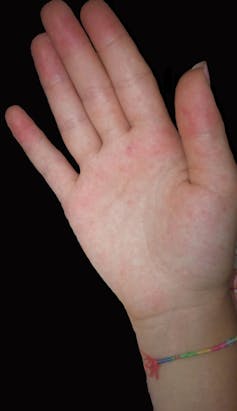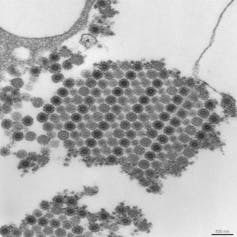Exotic" viruses in France: what do you need to know about chikungunya?
Since the start of the summer, a record number of native cases of chikungunya virus infection have been reported in France. Here's what you need to know about this virus, spread by mosquitoes belonging to the Aedes genus, such as the tiger mosquito Aedes albopictus.
Yannick Simonin, University of Montpellier

The chikungunya virus was first described in 1952 in Tanzania, on the Makonde plateau. Its name derives from the word meaning "to deform" in the Kimakonde language, spoken mainly in southeastern Tanzania. It describes the way in which the posture of sufferers, plagued by severe joint pain, changes during the course of the disease.
While most patients make a full recovery, the virus is particularly dangerous for newborns and the elderly. In many cases, it can also cause severe after-effects, such as joint pain and chronic fatigue. The latter can last for several months or even years, degrading the quality of life of those concerned.
Biology and transmission
The chikungunya virus (CHIKV) is an arthropod-borne virus (ARthropod-BOrne VIRUS). It is an enveloped virus with an RNA genome.
It is spread by the females of various species of mosquito belonging to the Aedes genus. TheAedes species most often responsible for its transmission are Aedes aegypti and Aedes albopictus, the infamous tiger mosquito. In rural areas of Africa, Aedes furcifer and Aedes africanus are also involved, along with several otherAedes species.
On the African continent, various animal reservoirs (primates, rodents, birds, etc.) have been identified as being involved in the virus cycle. The virus can therefore be transmitted from animals to humans, making it a zoonosis.
Cattle may also be a reservoir, but their role in transmission is unclear.

Although Aedes mosquitoes bite throughout the day, they are most aggressive in the mid-morning and mid-afternoon. The risk of disease transmission is therefore greater during this period.
When a female mosquito feeds on an individual whose blood contains the virus, the latter multiplies in the insect's body for around ten days, notably in its digestive system and salivary glands. When the infected mosquito bites a new target, it systematically injects its saliva, mainly to prevent blood coagulation and thus facilitate the blood meal. This is how it transmits the virus.
Once in the bloodstream of its new host, the virus multiplies again within a few days. Mosquitoes biting the newly-infected individual will in turn become infected, continuing the cycle of virus transmission... This is how outbreaks of indigenous cases, and even epidemics, arise.
During human outbreaks, it is the transmission of the virus from one person to another that sustains the epidemic. A person carrying the virus can transmit it during the "viremic" phase (when it is present in the blood), i.e. one to two days before the onset of symptoms and up to seven days afterwards.
Contamination can also occur through exposure to contaminated blood(transfusion, puncture with a contaminated needle, spraying or contact...). Although rare, the virus can also be transmitted from mother to child during childbirth, with serious consequences for the newborn.
Very fragile outside its host, the chikungunya virus survives poorly in the environment. Unlike many other viruses, it is not transmitted by contaminated objects or surfaces.
Symptoms
According to studies, infection with the virus is asymptomatic in only 5% to 40% of cases. The majority of those infected therefore develop symptoms, unlike other mosquito-borne viruses such as dengue or Zika.
In symptomatic people, signs of the disease generally begin one to twelve days after the bite of an infected mosquito(on average, two to three days).

This fever is accompanied by often severe joint pain, mainly affecting the extremities (hands and feet, wrists, ankles) as well as the knees, and more rarely the hips or shoulders. These pains are mainly related to the inflammation caused by the infection. Patients also often present with headaches and severe muscle pain(in 70% to 99% of cases), as well as a rash on the limbs and trunk.
Most patients make a full recovery. Fever generally disappears in two to seven days, rash in two to three days and joint pain in a few weeks.
However, in some people, particularly those over 40 or with a history of joint disease, a chronic form of the disease can set in. Certain symptoms then persist. In particular, joint pain can persist for up to several years after infection. This can be very disabling in everyday life, especially as it can be associated with chronic fatigue.
Some studies estimate that between 30% and 40% of symptomatic adult patients still experience persistent joint pain beyond three to six months, while 5-20% of symptomatic patients still report these symptoms two years after infection. Far from being trivial, these chronic conditions can therefore represent a very heavy societal burden, both in health and economic terms...
Occasional cases of ocular, neurological (encephalitis, Guillain-Barré syndrome) and cardiac (myocarditis) complications have also been reported.
Fortunately, deaths due to chikungunya are rare (between 0.1 and 1 per 1,000 symptomatic cases). They mainly concern newborns, for whom the disease is very dangerous, generating neurological and cardiac problems, as well as the elderly or those suffering from co-morbidities (the virus aggravates underlying pathologies).
Following exposure to the virus, our bodies develop a long-lasting immunity that generally persists for several years, even decades. In many cases, protection may even last a lifetime. Cases of re-infection are very rare, suggesting that this acquired immunity is sufficient to protect most people exposed to the virus.
Diagnosis and treatment
As the symptoms are very similar to those of other viruses, such as dengue or Zika, diagnosis can be difficult.
During the first week of illness, the virus can be detected in blood samples by RT-PCR. Later (after the fifth day), infection can also be confirmed by testing for antibodies to the virus.
There is no antiviral medication against the chikungunya virus. Treatment consists of relieving symptoms by administering analgesics/antipyretics, such as paracetamol, to combat pain and fever, and anti-inflammatories to treat joint problems.

Since June 2024, a vaccine against chikungunya, the Ixchiq vaccine from the Valneva laboratory, has had marketing authorization in the European Union. This is a live attenuated vaccine: it contains a strain of the chikungunya virus that has been weakened in the laboratory and can therefore no longer cause the disease, but can stimulate the immune system.
Implemented during the large-scale epidemic that hit La Réunion in 2025, vaccination has been suspended in subjects aged 65 and over, with or without comorbidities. Several cases of serious adverse reactions have been reported in this age group. Further investigations are underway to assess the benefit-risk balance in the elderly population, and adapt vaccination recommendations accordingly.
Epidemiology
The chikungunya virus has been circulating for several decades in Africa, India and Asia, as well as in the Indian Ocean. In fact, it was the epidemic that struck Reunion Island, along with Mauritius, Mayotte and the Seychelles, in 2005-2006, affecting 38.2% of the population, that helped bring it to the attention of the French public.
Prior to this first major epidemic, Réunion was not a zone where the chikungunya virus circulated, as Aedes aegypti, the main mosquito vector of this virus, was not established there. The tiger mosquito Aedes albopictus, on the other hand, did circulate there, but was not known to transmit the virus. It was later discovered that a mutation had enabled the virus to adapt to this mosquito, which became a new vector. Today, several strains of chikungunya virus are circulating, depending on whether they are adapted to Aedes aegypti or the tiger mosquito. Since this change, the range of the virus has altered considerably.
According to the World Health Organization (WHO), since 2004, outbreaks of chikungunya have been reported in over 110 countries in Asia, Africa, Europe and the Americas. They have become more frequent and more widespread asAedes aegypti orAedes albopictus populations have expanded.
In addition, adaptations have been detected that allow the virus to be more easily transmitted by the tiger mosquito. The fact that the virus has been introduced into previously unexposed (immunologically naïve) populations also explains the increased frequency of outbreaks.
Situation in France
In France, the risk of transmission of the chikungunya virus concerns both regions where Aedes aegypti is established, such as the West Indies (Guadeloupe, Martinique, Saint-Martin, Saint-Barthélemy) or French Guiana, and those where the tiger mosquito(Aedes albopictus) circulates, such as Reunion Island or mainland France. In Mayotte, which is home to both species of mosquito, the risk is high, notably due to a humid tropical climate.
Around 80% of French départements are considered to have the right conditions for the emergence of the disease, not least due to the continued expansion of the tiger mosquito in France. This mosquito is well established in France: in January 2024, it was present in 78 of the country's 96 départements, not only in the south, but also in the Île-de-France region and as far east as Paris.
Autochthonous cases of chikungunya - linked to infections in the country and not to travellers already infected on arrival - have been recorded in France in the past. The very first indigenous case of chikungunya in France was identified in Fréjus, Var, in September 2010. Since then, several sporadic outbreaks have been reported, mainly in the south of France, with an outbreak of 11 cases in Montpellier (Hérault) in 2014 and 17 cases in the Var in 2017.
The chikungunya virus was then more discreet, but in 2024, the first indigenous case was detected in the Île-de-France region, where the tiger mosquito has settled in recent years. The year 2025 looks set to be a record year, driven by the intense circulation of the virus on Reunion Island and Mayotte: by early July, some 30 native cases had already been detected in France.
How to prevent the disease
At present, the only way to combat the disease is to protect yourself from bites and fight the mosquitoes that spread it.
To avoid being bitten, wear light-colored clothing (which reduces visual and thermal attractiveness to mosquitoes), loose-fitting and covering clothing, skin repellents and mosquito nets (around your bed, windows, etc.).
To reduce the development of mosquito larvae, we recommend emptying all containers of stagnant water, especially flowerpot bowls and watering cans, and covering rainwater receptacles, especially during periods of heavy rainfall.
When a case of infection is reported, mosquito control operations are carried out in the vicinity of the detected cases, along with awareness-raising campaigns for the public and healthcare professionals (collaboration between regional health agencies, Santé publique France and mosquito control agencies such as Altopictus or theEntente interdépartementale de démoustication).
Tests to control mosquito vector populations using techniques such as sterile insects are also underway.
Yannick Simonin, Virologist specializing in the monitoring and study of emerging viral diseases. University Professor, University of Montpellier
This article is republished from The Conversation under a Creative Commons license. Read theoriginal article.